DUKINFIELD
Grid Ref: SJ 940 976
Date: 13 May 2009
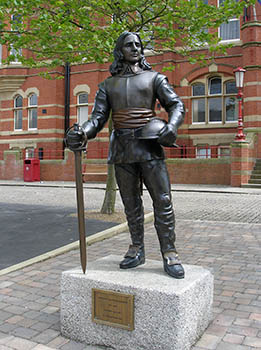 |
 |
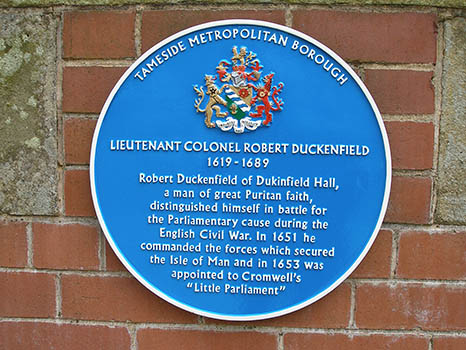 |
| Colonel Dukinfield |
|
Plaque to Robert Dukinfield |
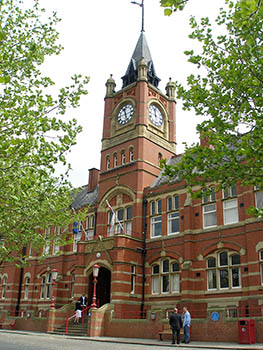 |
|
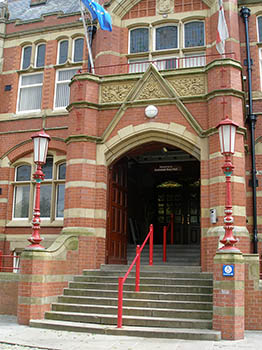 |
| Town Hall |
|
The entrance to the town hall |
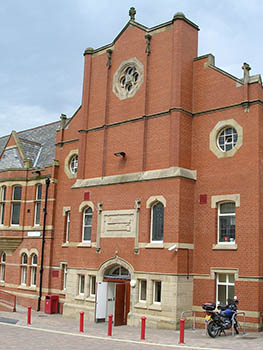 |
|
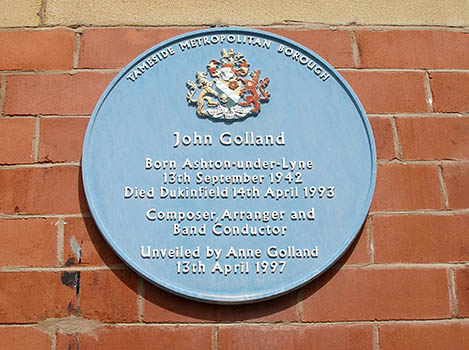 |
| The east side of the Town Hall |
|
Plaque to John Golland on the side of the Town Hall |
Dukinfield in now part of Tameside but was historically in the county of Cheshire and is covered in Pevsner's Buildings of England in the volume on Cheshire. Dukinfield is separated from Ashton under Lyne, which is in Lancashire, by the river Tame. The name of the town has been spelled in various ways and as seen in the plaque above, Colonel Dukinfield is spelled Dukenfield and in the pedigree other variants are seen. The Town Hall was built in 1899 and the architect was John Eaton, Sons and Cantrell of Ashton.
COLONEL ROBERT DUKINFIELD
Civil War Commander
Colonel Robert Dukinfield came from Dukinfield in North East
Cheshire. During the Civil War he was one of the leading Parliamentarians
in the Civil War. He defended Stockport Bridge against Prince Rupert and conducted
the siege of Wythenshawe. He became High Sheriff
of Cheshire in 1625. In 1650, during the Commonwealth period he was made the
Governor of Chester. The following year, he was a member of the court martial
that sentenced the Earl of Derby, a Royalist Commander, to death. Lord Derby
had estates in the Isle of Man and Robert Dukinfield was sent out as the head
of an expeditionary force to the island against the Countess of Derby. She
surrendered the island after receiving a letter from the Earl noting "that
the Colonel, being so much of a gentleman born, will doubtless, for his own
honour, deal fairly with you."
Towards the end of the Commonwealth, there was a rebellion against
Richard Cromwell, led by Sir George Booth of Dunham Massey. Booth had also
been a leading supporter of the Parliamentary cause but became disillusioned
with the new dictatorship. Robert Dukinfield was the main commander involved
in suppressing this rebellion. He lived to see the Restoration and the "Glorious
Revolution" of William and Mary. His son, also Robert, was made a baronet shortly
after the Restoration. Colonel Robert Dukinfield died at Dukinfield Hall in
1689, aged 70.
Next to Dukinfield Hall lies what is believed to be the oldest
Nonconformist Chapel in England. It was a domestic chapel; Sir Robert Dukinfield
and other members of the family were buried in it. Colonel Dukinfield was
buried at the old chapel, Denton. Several members of the family were buried
at Cross Street Chapel in Manchester. The Dukinfield estates formerly comprised
all Dukinfield and large parts of Newton, Denton, Haughton, Reddish, Brinnington,
Portwood and other parts of Stockport, land in Tabley and also estates in
Lancashire. The township of Dukinfield became a part of the parish of Stockport
although detached from it, probably through the influence of the family. A
Robert de Dukinfield is recorded as the resident owner of the township in
1315.
Sir William Dukinfield Daniel, the great grandson of Colonel
Dukinfield, died in 1758 and left his estate to his daugther Henrietta. She
was pronounced insane and died in 1771. The estate then passed to her step-father
John Astley of Wem, a painter and a friend of Sir Joshua Reynolds. John Astley
died in 1787 and was buried in the Old Chapel Yard. His son, named Francis
Dukinfield-Astley was involved in the industrial revolution with interests
in coal mining and iron works. In 1802 he was awarded the Silver Medal of
the Society for the Improvement of Agriculture for planting 40,000 trees.
A family tree of the Dukinfields is included in Earwaker's 'East Cheshire',
from which the following version is taken. Earwaker's tree starts with Robert
de Dokenfield in the 13th century but I begin in the late 14th century and
proceed as far as Colonel Dukinfield. Note that a variety of spellings of
the name are used in different documents.
-
1. Robert de Dokenfield, born about 1379 and known to be
living in 1442. Wife not known. In addition to his heir John he had two
daughters, Agnes who married John de Rokeby and Margaret who married Ralph
de Hyde. .
- 2. John de Dokenfield, living in 1437 and above the age of 21. Died
1473. John had a second wife, Alice, but there is no known issue.
- + 1st. Katherine, d. of Sir John Assheton of Ashton-under-Lyne.
This couple, in addition to the heir Robert, also had two other son, John
and Thomas, of whom little is known and two daughters, Lucy who married
Otho Reddish, and Ellin who married Richard Vernon.
- 3. Robert de Dokenfield was called Robert senior in 1467 and 1481.
- + Elizabeth, daughter of Robert Legh of Adlington. In
addition to Robert, their eldest son, they had a son John and a daughter
Katherine who married Charles Mainwaring.
- 4. Robert Dokenfield, known to be living in the period from
1487 to 1507.
- + Elizabeth Merfield of Yorkshire. In addition to their eldest
son John they had a son Nicholas and a daughter Jane who married
Laurence Dutton of Dutton in Cheshire who died in 1526.
- 5.John Dokenfield, known to be living in 1523 and 1528 but
died before 1529.
- + Jane daughter or Sir Nicholas Longford of Longford in
Derbyshire. This couple had in addition to the heir Robert
the following: John and Francis, who died young; Ralph who
was living in 1530; William; Thurstan, living in 1530; Thomas;
Edmund of Taunton in Ashton-under-Lyne who married Emlyn widow
of Alex Newton of Newton, he died 1600; Isabel, who married
Sir George Stanley who died in 1570; Katherine who married
Robert Hyde of Norbury; Alice, Jane and Dorothy.
- 6. Robert Dokenfield of Dokenfield died in 1548.
- + Ellen daughter of Sir William Brereton of Brereton,
Knt. Their eldest son, John, died in the lifetime
of this father and the second son, William, succeeded.
Other children were Robert; Edward, who died young; Ralph
who died in 1619; Ellen who married John Dutton of New
Manor near Daresbury in Cheshire.
- 7. William Dokenfield, eldest surviving son, born
1535, a groom of the King's Privy Chamber in 1551,
buried Stockport 21 June 1592. William's second wife
was Margery d. Edward Holland of Denton, married before
1580.
- + 1st Jane dau of John Arderne of Harden,
Esq., in 1551 but she died before 1580. This couple's
eldest son, William, died in the lifetime of his father
and was buried at Stockport in 1590. The second son
Robert succeeded. Other children were John, living
in 1599; Ralph, who died before 1580; Joseph who died
in 1598; Judith who married William Nicholson in 1606;
Jane who married William Bamford of Lancashire about
1596 and died in 1602 and Sarah, who died as an infant.
- 8. Robert Duckenfield of Duckenfield, Esq.,
died 1621.
- + Jane, daughter and coheiress of Richard Holland
of Denton, married about 1593 and she died in
1610. In addition to their eldest son Robert they
had: William, baptised in 1598 and died in 1632;
Richard, bapt 1608 who had no issue; Margaret,
bapt 1594 who married Laurence Downes of Worth,
Chester before 1612; Mary, bapt 1595, who married
Richard Holt of Ashworth in Lancashire in 1614;
Katherine, bapt 1601, who married John Tempest
of Tonge in Yorkshire; Dorothy, bapt in 1602,
who married Edmund Ashton of Chadderton in Lancashire
in 1618; Francers, bapt in 1603, who married Peter
Shaw of Bickersteth in Lancashire; Jane, bapt
1596; Elizabeth, bapt 1599 and died aged 3 months;
Ellen, bapt 1604 and died 1605; Alice, bapt January
1605/6 and still living in 1621.
- 9. Robert Duckenfield of Duckenfield, Esq.,
bapt Ashton-under-Lyne, 14 Aug 1597, buried
Stockport 30 August 1630.
- + Frances, daughter of George Preston of
Holker in Lancashire at Cartmel, 23 August
1618. In addition to their eldest son Robert
this couple had William, bapt 14 April 1622
who married Eleanor, daughter of Sir Dudley
Loftus of Killyan in Ireland; James, bapt
25 May 1624 of Gray's Inn and in 1664 of Hindley
Hall near Wigan, married Radcliffe, daughter
of Richard Bold of Bold in Lancashire; Thomas,
baptised in 1625 and died unmarried; Col.
John Duckenfield, bapt at Ashton in March
1626/7, married Hannah Franklin at St. Martin's-in-the-Fields
in 1659 and died 1677; Margaret, bapt 1629,
married Joshua Radcliffe of Todmorden; Elizabeth,
baptised 1628, married Thomas Atkinson of
Cockfosters, Middlesex.
- 10. Colonel Robert Duckinfield
of Duckinfield, baptised Stockport, 28
August 1619, Colonel in the army of Parliament
and Governor of Chester in 1650. High
Sheriff of Chester 1649, entered his pedigree
with Visitation of Chester in 1663. Buried
at Denton, 21 September, 1689.
- + 1st wife of Colonel Robert Duckinfield, Martha, daughter of Sir Miles
Fleetwood of Hesketh, Lancashire, Knt.
Receiver of the Court of Wards. Died 1669.
- 11. Sir Robert Duckenfield of
Duckenfield, 1st Baronet, created
16 June 1665, born about 1642, High
Sheriff of Cheshire in 1675, buried
at Duckinfield Hall Chapel in November
1729 aged 87.
- + 1st wife of Sir Robert, Jane, daughter of Sir Thomas
Estcourt of Cheristoc Pinkney in Wiltshire,
c. 1665, she died on 19 August 1678.
- 12. Robert, baptised 1668 and
died 1680
- 12. Sir Charles Dukinfield,
2nd Baronet, born 18 November
1670, lived Macclesfield 1700
to 1720 and died 23 Feb 1741/2.
(see separate tree below)
- 12. John, bapt Feb 1671/2 and
died April 1672.
- 12. John who became a merchant
of Bristol, baptised 28 Aug 1677
and died 1741. He married Ann
Andews of Bristol and had seven
sons and four daughters. Four
sons and all daughters died young
or without issue. Robert, the
eldest son married Isabella daughter
of John Miller of Jamaica and
had one daughter, Isabella who
died in infancy. The remaining
son was Samuel.
- 13. Sir Samuel Dukinfield
of Bloomsbury, succeeded his
cousin as 4th Baronet.
He died 15 May 1768 and was
buried in London without issue.
- + Elizabeth daughter of
Poulett Warner of Badmonisfield
Hall, Wickhambrook, Suffolk
- + 2nd wife of Sir Robert, Susanna, daughter of Robert
Thomson of Culpho in Suffolk, Governor
of the East India Company. Married
7 Aug 1683 at Shoreditch. She died
7 July 1742 and was buried at Cross
Street Chapel in Manchester.
- 11. William Duckenfield living 1650
and 1663 of Chowam in North Carolina,
will of 1719, no issue.
- 11. Charles Duckenfield, living
in 1650.
- 11. John Duckenfield buried in London,
1673.
- 11. Anne, living in 1650
- 11. Martha and Mary died young
- 11. Elizabeth, mentioned in Cheshire
Visitation of the Heralds in 1663.
- + 2nd wife of Colonel Robert Duckinfield
was Judith dau of Nathaniel Bottomley
of Cawthorne, Yorkshire.
- 11 Richard, probably the eldest
son but who died on 28 July 1700.
- 11. Rev. Joseph Duckenfield, born
c. 1681, a Nonconformist minister who
later conformed and was Vicar of Felixkirk,
Yorkshire, dying on 5 April 1739
- 11. Benjamin baptised at Dukinfield
Chapel 22 August 1682
- 11. John, born c. 1686, died 25
Oct 1762, buried at Dukinfield Nonconformist
Chapel.
- 11. Martha, bapt. Duckinfield Chapel,
24 June 1684, buried 13 April 1698
- 11. Judith, bapt. Duckinfield Chapel,
12 March, 1689/90, married Rev. William
Buckley the Minister at Duckinfield
Chapel and was buried there in 1766.
Sources:
Cheshire Notes and Queries, Vol. 1, page 141.
Old Chapel and the Unitarian Story, by David C. Doel, a Unitarian Publication,
London, ISBN, 085319 0496.
East Cheshire Past and Present by J.P.
Earwaker, London, 1877
The Buildings of England: Cheshire, by Nikolaus Pevsner and Edward Hubbard, first edition 1971, Yale University Press edition in 2003.
Back to list of families
Introduction to Cheshire Gentry











